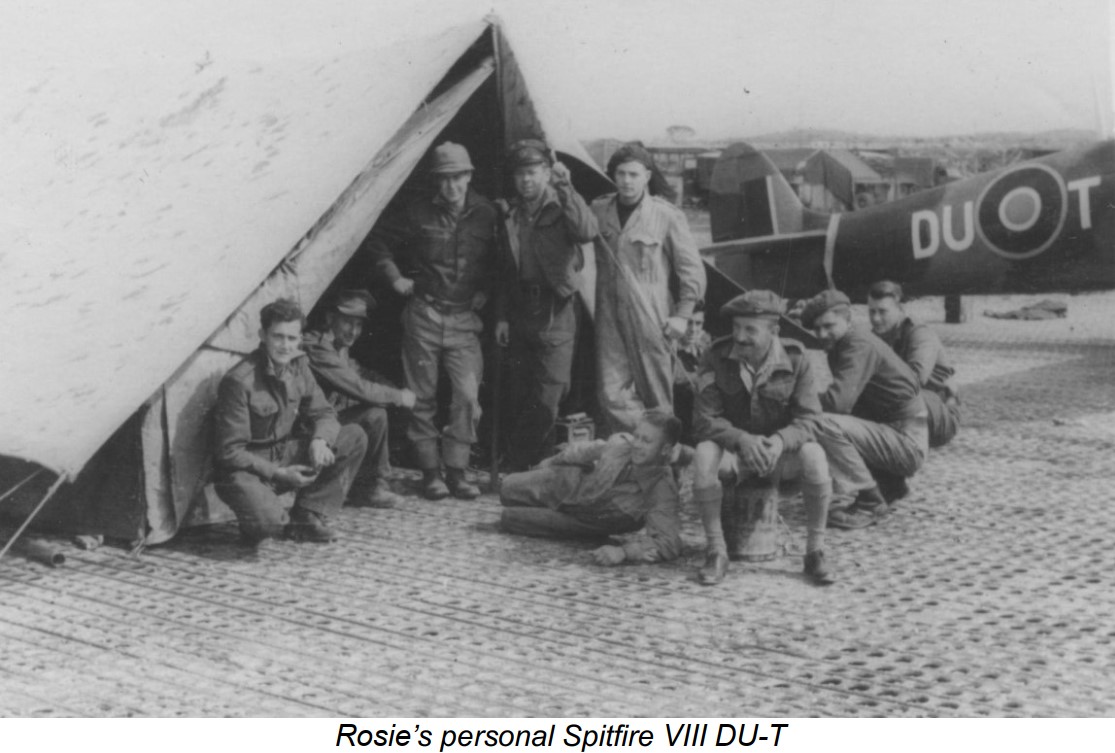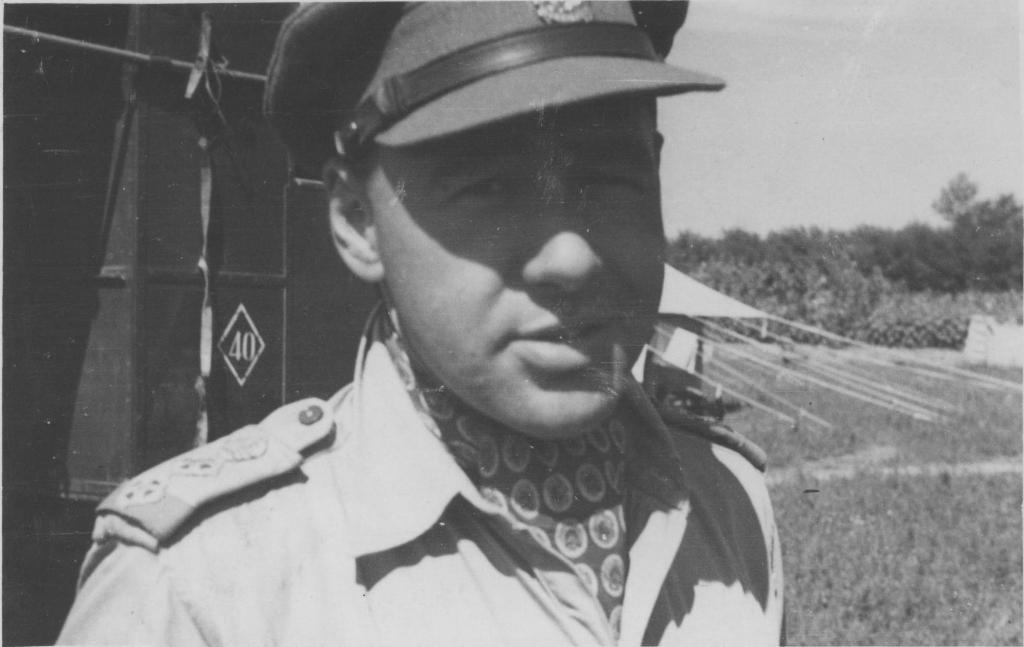DUTOIT, Stephanus F
Stats:
rank: Colstatus: survived
airforce: SAAF (no: P102712 )
born: 1919-01-28 Groot Marico South Africa
added by: shosoloza
Bio / Text:
Colonel S. F. “Rosy” du Toit was one of that resolute band of South African Air Force pilots who made such a remarkable contribution first to the air campaign against the Italians in Abyssinia (Ethiopia) in 1941 and thereafter, with ever increasing effectiveness, in the Western Desert and Italy right to the end of the Second World War. Rosy became the youngest officer in the SAAF to command a fighter wing in operations. He was decorated with CBE, DFC and Bar, US DFC and served in Abyssinia, North Africa from EL Alamein to Tunis and in the Italian campaign with 7 Wing and 8 Wing
The SAAF was flung into action over the unutterably hostile terrain of Ethiopia in 1941 as part of a motley contingent of (mostly obsolete) aircraft rushed up from South Africa to bases in Kenya and then Somalia, after Mussolini had entered the war against Britain and France in the summer of 1940.
The SAAF subsequently went on to distinguished itself in fighter and fighter-bomber operations against Axis forces with the Desert Air Force in North Africa where du Toit commanded a squadron. He became a wing leader in 1944, commanding 8 Wing in operations in Italy from August 1944 as it supported both British and US forces in the drive northwards to the Austrian frontier.
By the end of the war he had been awarded two DFCs, had been appointed CBE and was awarded the US Distinguished Flying Cross for his part in operations in support of the US 5th Army in Northern Italy.
Stephanus Francois du Toit was born in Zeerust, Transvaal, in 1919. In 1938 he enlisted in the South African Air Force and was commissioned in the following year. He acquired his nickname “Rosy” from the wartime term for a yellow duster used to polish leather and brass. He was always so immaculately turned out that his colleagues in training teased him that he carried one in his pocket to administer a last-minute buff-up to his kit before inspections. Shortly before the war he was stationed at Waterkloof Air Station with No2 Squadron, still flying biplane Hawker Fury fighter-bombers.
After the Italians invaded British Somaliland in August 1940, he was transferred to the newly formed 41 Squadron flying the Hawker Hartebees — a general-purpose development of the Hart bomber developed especially for the SAAF. No 41 was first sent to a base at Mogadishu in Italian Somaliland, which was occupied by the British in 1941. During the counter-offensive against the Italians in the Horn of Africa in 1941 du Toit and his squadron took part in strafing, bombing, artillery spotting and reconnaissance operations and he was mentioned in dispatches.
After Italian resistance in the Horn of Africa ceased in November 1941, he was posted for a second tour of operations to the Western Desert where, having been promoted to major, he commanded a squadron of P40 Kittyhawks in 1942-43. In the intense air-to-air and ground-attack fighting that took place in the desert as the fortunes of the Axis and British and Commonwealth forces swayed to and fro, du Toit and his fellow pilots were at the heart of an assault that took a terrible toll of Rommel’s supply lines. On April 5, 1943, he was part of a 7 Wing sortie that shot down 31 of the massive six-engined Me323 Gigant transports, carrying fuel which, as he recorded, “burst into flames on impact with the water, giving the impression that the sea was alight”.
He was awarded his first DFC in June 1943.
His next tour was in Italy where he commanded 4 Squadron, flying cannon-armed ground-attack Spitfires before being promoted to sweep leader of 7 Wing in October 1943. For his leadership and skill in these operations he received a Bar to his DFC.
After six months at the RAF Staff College Haifa as a colonel he was back on operations for a remarkable fourth tour in August 1944, this time commanding the newly formed 8 Wing SAAF, which consisted of three Spitfire (Spit-bomber) squadrons and a Kittybmber (Curtiss Kittyhawk) squadron.. Operating in support of the US 5th Army under the aegis of XXII Tactical Air Command USAAF as the Allied advance pushed northwards, 8 Wing took part in a relentless pursuit and with 7 Wing spearheaded the final air assault on German forces through the latter half of 1944 and 19451945. By the time the Germans surrendered in northern Italy on May 2, du Toit had been part, almost continuously, of a process that had taken the SAAF from El Alamein through Tunis to Sicily and Italy and thence to the Alps. He had also been in action in Yugoslavia, knocking out German airfields in support of Tito’s partisans, for which he was awarded the US Distinguished Flying Cross and presented with the insignia of the CBE by King George VI at Buckingham Palace. Although there was something of a surfeit of senior officers at the end of the war, du Toit was able to remain in the SAAF and went to the US on an officer exchange programme.
He also held an appointment as a station commander, before being demobbed in 1948. It was the year of the victory of the National Party in the general election in South Africa, and marked a drive in the forces to curtail the advancement of those who had served with the Allies and were deemed “too British”, as well as anyone not in harmony with the new Government’s racial policies.
Over the next 20 years he farmed near the Mozambique border, and in what was then Rhodesia, and spent several years in the 1970s and 1980s ranching in New Mexico.
In the 1980s he returned to the Cape where he lived in retirement. Du Toit was three times married: his first wife, an American nurse whom he had met while in Italy predeceased him; his second marriage was dissolved; his third wife, Doreen, survives him. He had no children.
Colonel Stephanus F. “Rosy” du Toit, CBE, DFC and Bar, US DFC, wartime fighter and fighter-bomber pilot, was born on January 28, 1919. He died on February 13, 2009, aged 90
The SAAF was flung into action over the unutterably hostile terrain of Ethiopia in 1941 as part of a motley contingent of (mostly obsolete) aircraft rushed up from South Africa to bases in Kenya and then Somalia, after Mussolini had entered the war against Britain and France in the summer of 1940.
The SAAF subsequently went on to distinguished itself in fighter and fighter-bomber operations against Axis forces with the Desert Air Force in North Africa where du Toit commanded a squadron. He became a wing leader in 1944, commanding 8 Wing in operations in Italy from August 1944 as it supported both British and US forces in the drive northwards to the Austrian frontier.
By the end of the war he had been awarded two DFCs, had been appointed CBE and was awarded the US Distinguished Flying Cross for his part in operations in support of the US 5th Army in Northern Italy.
Stephanus Francois du Toit was born in Zeerust, Transvaal, in 1919. In 1938 he enlisted in the South African Air Force and was commissioned in the following year. He acquired his nickname “Rosy” from the wartime term for a yellow duster used to polish leather and brass. He was always so immaculately turned out that his colleagues in training teased him that he carried one in his pocket to administer a last-minute buff-up to his kit before inspections. Shortly before the war he was stationed at Waterkloof Air Station with No2 Squadron, still flying biplane Hawker Fury fighter-bombers.
After the Italians invaded British Somaliland in August 1940, he was transferred to the newly formed 41 Squadron flying the Hawker Hartebees — a general-purpose development of the Hart bomber developed especially for the SAAF. No 41 was first sent to a base at Mogadishu in Italian Somaliland, which was occupied by the British in 1941. During the counter-offensive against the Italians in the Horn of Africa in 1941 du Toit and his squadron took part in strafing, bombing, artillery spotting and reconnaissance operations and he was mentioned in dispatches.
After Italian resistance in the Horn of Africa ceased in November 1941, he was posted for a second tour of operations to the Western Desert where, having been promoted to major, he commanded a squadron of P40 Kittyhawks in 1942-43. In the intense air-to-air and ground-attack fighting that took place in the desert as the fortunes of the Axis and British and Commonwealth forces swayed to and fro, du Toit and his fellow pilots were at the heart of an assault that took a terrible toll of Rommel’s supply lines. On April 5, 1943, he was part of a 7 Wing sortie that shot down 31 of the massive six-engined Me323 Gigant transports, carrying fuel which, as he recorded, “burst into flames on impact with the water, giving the impression that the sea was alight”.
He was awarded his first DFC in June 1943.
His next tour was in Italy where he commanded 4 Squadron, flying cannon-armed ground-attack Spitfires before being promoted to sweep leader of 7 Wing in October 1943. For his leadership and skill in these operations he received a Bar to his DFC.
After six months at the RAF Staff College Haifa as a colonel he was back on operations for a remarkable fourth tour in August 1944, this time commanding the newly formed 8 Wing SAAF, which consisted of three Spitfire (Spit-bomber) squadrons and a Kittybmber (Curtiss Kittyhawk) squadron.. Operating in support of the US 5th Army under the aegis of XXII Tactical Air Command USAAF as the Allied advance pushed northwards, 8 Wing took part in a relentless pursuit and with 7 Wing spearheaded the final air assault on German forces through the latter half of 1944 and 19451945. By the time the Germans surrendered in northern Italy on May 2, du Toit had been part, almost continuously, of a process that had taken the SAAF from El Alamein through Tunis to Sicily and Italy and thence to the Alps. He had also been in action in Yugoslavia, knocking out German airfields in support of Tito’s partisans, for which he was awarded the US Distinguished Flying Cross and presented with the insignia of the CBE by King George VI at Buckingham Palace. Although there was something of a surfeit of senior officers at the end of the war, du Toit was able to remain in the SAAF and went to the US on an officer exchange programme.
He also held an appointment as a station commander, before being demobbed in 1948. It was the year of the victory of the National Party in the general election in South Africa, and marked a drive in the forces to curtail the advancement of those who had served with the Allies and were deemed “too British”, as well as anyone not in harmony with the new Government’s racial policies.
Over the next 20 years he farmed near the Mozambique border, and in what was then Rhodesia, and spent several years in the 1970s and 1980s ranching in New Mexico.
In the 1980s he returned to the Cape where he lived in retirement. Du Toit was three times married: his first wife, an American nurse whom he had met while in Italy predeceased him; his second marriage was dissolved; his third wife, Doreen, survives him. He had no children.
Colonel Stephanus F. “Rosy” du Toit, CBE, DFC and Bar, US DFC, wartime fighter and fighter-bomber pilot, was born on January 28, 1919. He died on February 13, 2009, aged 90
Squadrons:
| Squadrons add | |||
|---|---|---|---|
| Airforce | Sqdrn | Start | Finish |
| SAAF | 41 | 1940-10-17 | -- |
| SAAF | 7 Wing | 1943-10-06 | -- |
| SAAF | 4 | 1942-06-01 | -- |
| SAAF | 8 Wing | 1944-07-16 | -- |
Aircraft:
| Aircraftadd | ||
|---|---|---|
| Serial | Note | Date |
| 865 | 1941-08-25 | |
| 833 | 1941-11-06 | |
| DU-T | 1942-07-01 | |
| KJ-O | 1942-10-01 | |
post
Comments / Questions:
post





